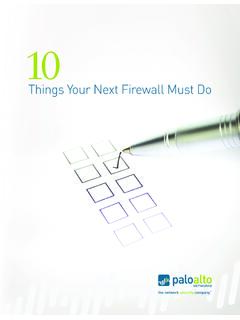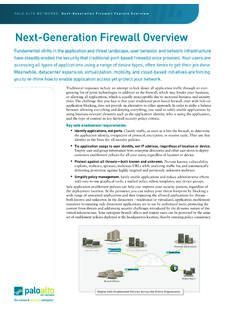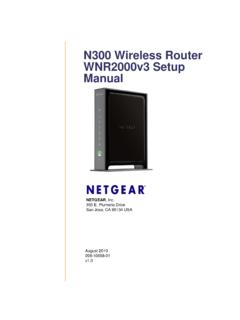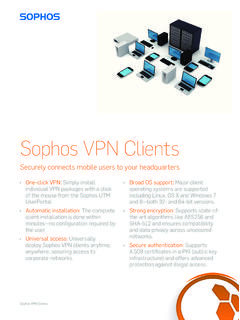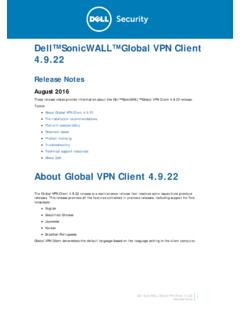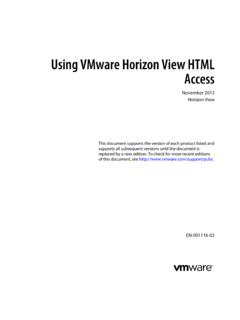Transcription of Configuring GlobalProtect - Palo Alto Networks
1 Revision E 2012, Palo Alto Networks , Inc. Configuring GlobalProtect Tech Note PAN-OS 2012, Palo Alto Networks , Inc. [2 ] Contents OVERVIEW ..4 GlobalProtect ELEMENTS ..4 LICENSE REQUIREMENTS ..4 DEPLOYMENT TOPOLOGIES ..4 SINGLE GATEWAY FOR REMOTE ACCESS VPN .. 5 NETCONNECT FUNCTIONALITY - GlobalProtect FOR REMOTE ACCESS VPN ..5 NETWORK TOPOLOGY .. 6 STEP1: CREATE SERVER CERTIFICATE ..7 STEP2: Configuring USER AUTHENTICATION ..7 STEP3: CREATE A TUNNEL INTERFACE ..7 STEP4: CONFIGURE THE GATEWAY ..8 STEP5: CONFIGURE PORTAL ..9 STEP 6: DOWNLOAD AND ACTIVATE THE GlobalProtect CLIENT .. 11 CLIENT CONNECTION .. 12 VERIFICATION .. 13 OTP CONSIDERATIONS .. 13 VERIFICATION.
2 15 Viewing the active flow .. 15 Viewing the gateway configuration .. 16 Configuring GlobalProtect WITH MULTIPLE GATEWAYS AND HOST CHECKS .. 17 SEQUENCE OF STEPS .. 17 SOFTWARE REQUIREMENTS .. 18 CONFIGURATION STEPS .. 18 CERTIFICATES .. 19 Generating CA Certificate .. 19 Generating a Gateway certificate .. 19 Generating a Client Certificate .. 20 Creating a Client Certificate Profile .. 21 Configuring USER AUTHENTICATION .. 21 Local Database .. 22 RADIUS .. 22 Kerberos .. 22 LDAP .. 23 Authentication Profile .. 23 Configuring THE GATEWAY .. 24 PORTAL CONFIGURATION .. 26 HOST INFORMATION OBJECTS AND PROFILES .. 33 2012, Palo Alto Networks , Inc. [3 ] HIP OBJECTS .. 33 HIP objects checking registry keys.
3 35 HIP PROFILES .. 35 Configuring MULTIPLE GlobalProtect GATEWAYS .. 36 DOWNLOAD AND ACTIVATE THE GlobalProtect CLIENT ON THE FIREWALL .. 37 DISTRIBUTING GlobalProtect CLIENT .. 37 ESTABLISHING CONNECTION .. 38 LOGGING AND REPORTING .. 39 HIGH AVAILABILITY .. 40 SCALING .. 40 View the active Gateway flow from the CLI: .. 40 View the Gateway configuration from the CLI: .. 41 To view the users connected: .. 41 To view the tunnels established: .. 42 To troubleshoot HIP related issues .. 42 Show the current state of the HIP cache in management plane .. 42 GP Client logs .. 42 Address allocation 43 REVISION HISTORY .. 44 2012, Palo Alto Networks , Inc. [4 ] Overview GlobalProtect provides security for host systems, such as laptops, that are used in the field by allowing easy and secure login from anywhere in the world.
4 With GlobalProtect , users are protected against threats even when they are not on the enterprise network, and application and content usage is controlled on the host system to prevent leakage of data, etc. With PAN-OS release , GlobalProtect replaces NetConnect functionality. This document also covers, Configuring GlobalProtect for remote access VPN replacing NetConnect GlobalProtect Elements There are three essential components that make up the GlobalProtect solution: GlobalProtect Portal: A Palo Alto Networks next-generation firewall that provides centralized control over the GlobalProtect system. Portal maintains the list of all Gateways, certificates used for authentication, and the list of categories for checking the end host.
5 GlobalProtect Gateway: One or more interfaces on one or more Palo Alto Networks next-generation firewalls that provide security enforcement for traffic from the GlobalProtect Client. The Gateways can be either internal in the LAN or external, where they are deployed to be reachable via the public internet GlobalProtect Client: The client/Agent software on the laptop that is configured to connect to the GlobalProtect deployment. License requirements GlobalProtect portal license is one time permanent license. The gateway license is a one or three year subscription license. 1. No license is required for single portal/ gateway deployment without Host checks 2. Only a portal license is required for multiple gateway deployment without Host check 3.
6 Portal license and gateway subscription license is required when Host check is implemented, either with single or multiple gateways Deployment Topologies The simplest form of deployment is a single firewall acting as both the Gateway and Portal. For larger deployments, geographically dispersed Gateways and a centralized Portal are used. This allows the Client to connect to the closest Gateway. Some of the common deployment topologies are shown below. 2012, Palo Alto Networks , Inc. [5 ] Single gateway for remote access VPN Multiple Gateways NetConnect Functionality - GlobalProtect for Remote Access VPN This section provides configuration example of using GlobalProtect for remote access VPN. This is applicable for PAN-OS release , where NetConnect function is no longer available.
7 Use this configuration for just remote access, with no host checks or multiple gateways, similar to NetConnect. Note: This feature does not require both the GlobalProtect gateway and portal license. 2012, Palo Alto Networks , Inc. [6 ] Hardware and Software requirements All Palo Alto Networks firewall PAN-OS version GlobalProtect Client: Download and activate the GlobalProtect Client. GlobalProtect Client supports 32-bit XP, both 32-bit and 64-bit of Vista and windows 7, Mac OS Network Topology In this example, the firewall will be configured with details shown below Tunnel interface : Tunnel interface for VPN termination Authentication method: Local DNS Server: IP pool : DNS suffix: Access route: Interface Comment Zone Virtual Router Ethernet 1/3 Outside interface.
8 This is IP address of the Portal and Gateway L3-outside default Ethernet 1/1 Inside interface. Connects to protected resource L3-inside default Tunnel Logical interface for terminating VPN tunnel VPN default Note: 1. By binding the tunnel interface in the same zone as the interface connecting the protected resources, the remote users can access the resource without the need of security policy coming through the tunnel. For stricter policy enforcement it is recommended to assign the tunnel interface to its own zone, example VPN zone and then create policies between the VPN zone and L3-inside to securely enable access to the protected resources 2. Loopback interface can also be used as the portal and gateway interface 2012, Palo Alto Networks , Inc.
9 [7 ] Step1: Create Server Certificate Create a certificate with similar parameters as shown to be used by the Portal and Gateway. The common name must be the IP address of the FQDN of the interface where the remote users connect to. Step2: Configuring User Authentication Identify the authentication method that will be using to authenticate GlobalProtect users. Palo Alto Networks next-generation firewalls support local database, LDAP, RADIUS or Kerberos authentication servers for authenticating users. In this example we will use the local database for authenticating users. To create a local users navigate to Device > Local User Database > Users and click on add to add a new user. Note: To learn more about using other mechanism of user authentication refer to the section Configuring User authentication Step3: Create a Tunnel Interface The tunnel interface is a logical interface that is only used for terminating VPN tunnels.
10 It can be used both for site-to-site IPSec VPN and remote access VPN. There is a pre-defined tunnel interface tunnel . You can use either the pre-defined tunnel interface or create a separate tunnel interface. In this example we use the 2012, Palo Alto Networks , Inc. [8 ] pre-defined tunnel interface. The tunnel interface must also be assigned to a virtual router and bound to a security zone. Step4: Configure the Gateway The remote access connections from users terminate on the gateway. General Tab Specify the gateway name and select the server certificate created in Step1 If you want the remote users to establish a secure connection using IPSec to the gateway, select Tunnel Mode , selecct the tunnel interface and check Enable IPSec.
